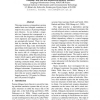Free Online Productivity Tools
i2Speak
i2Symbol
i2OCR
iTex2Img
iWeb2Print
iWeb2Shot
i2Type
iPdf2Split
iPdf2Merge
i2Bopomofo
i2Arabic
i2Style
i2Image
i2PDF
iLatex2Rtf
Sci2ools
ACL
2010
2010
Bitext Dependency Parsing with Bilingual Subtree Constraints
This paper proposes a dependency parsing method that uses bilingual constraints to improve the accuracy of parsing bilingual texts (bitexts). In our method, a targetside tree fragment that corresponds to a source-side tree fragment is identified via word alignment and mapping rules that are automatically learned. Then it is verified by checking the subtree list that is collected from large scale automatically parsed data on the target side. Our method, thus, requires gold standard trees only on the source side of a bilingual corpus in the training phase, unlike the joint parsing model, which requires gold standard trees on the both sides. Compared to the reordering constraint model, which requires the same training data as ours, our method achieved higher accuracy because of richer bilingual constraints. Experiments on the translated portion of the Chinese Treebank show that our system outperforms monolingual parsers by 2.93 points for Chinese
| Added | 10 Feb 2011 |
| Updated | 10 Feb 2011 |
| Type | Journal |
| Year | 2010 |
| Where | ACL |
| Authors | Wenliang Chen, Jun'ichi Kazama, Kentaro Torisawa |
Comments (0)

